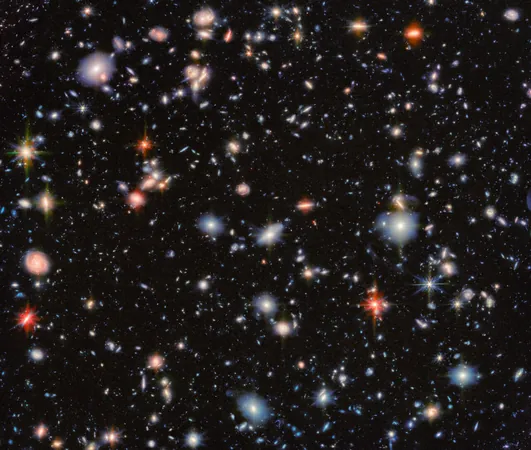
James Webb Telescope Unveils Its Most Stunning Cosmic Snapshot Yet!
2025-08-10
Author: Ken Lee
A New Era of Cosmic Discovery
The James Webb Space Telescope (JWST) has taken a extraordinary leap in cosmic exploration, capturing the deepest view of the universe ever observed. This new survey goes beyond anything we've seen before, unveiling fainter and more distant objects that date back to the universe's infancy.
Building on Hubble's Legacy
In a stunning tribute to previous astronomical marvels, JWST has revisited the same patch of sky that NASA’s Hubble Space Telescope first explored in 2004. Hubble's Ultra Deep Field image astonished astronomers by revealing nearly 10,000 galaxies in what seemed like a blank space in the night sky. Now, JWST has pushed the boundaries further by identifying an additional 2,500 galaxies that are even more distant, expanding our understanding of cosmic history.
The MIRI Deep Imaging Survey: A Game-Changer
The new findings, part of the MIRI Deep Imaging Survey (MIDIS), represent the deepest mid-infrared view of this cosmic region to date. Utilizing nearly 100 hours of detailed observing time harnessing its advanced Mid-Infrared Instrument (MIRI) and Near-Infrared Camera (NIRCam), JWST has revealed hundreds of extremely red galaxies—some potentially formed less than a billion years after the Big Bang!
Longest Exposure Yet!
At the heart of this captivating image lies one remarkable exposure: JWST dedicated an astonishing 41 hours using a single filter to scrutinize the night sky. This unprecedented observation has revealed galaxies in mid-infrared light—an area beyond Hubble's reach—showcasing previously hidden sections of dust and ancient red stars.
Decoding the Cosmic Palette
Capturing light beyond the human eye's spectrum presents a unique challenge: how to visually interpret these extraordinary images? Researchers have crafted filters that assign distinctive colors to different wavelengths. In this striking image, galaxies rich in dust and star formation shine in shades of orange and red, while compact distant galaxies appear greenish, and near-infrared-bright galaxies exhibit blue and cyan hues.
A Leap Forward in Astronomy
Details of this groundbreaking imagery have been documented in the journal Astronomy & Astrophysics, where researchers have included interactive tools like a slider and videos allowing us to compare JWST’s findings directly with Hubble's original Ultra Deep Field.
This remarkable feat not only deepens our understanding of the universe but also shapes the future of astronomical study, providing invaluable insights into the formation and evolution of galaxies over billions of years.

 Brasil (PT)
Brasil (PT)
 Canada (EN)
Canada (EN)
 Chile (ES)
Chile (ES)
 Česko (CS)
Česko (CS)
 대한민국 (KO)
대한민국 (KO)
 España (ES)
España (ES)
 France (FR)
France (FR)
 Hong Kong (EN)
Hong Kong (EN)
 Italia (IT)
Italia (IT)
 日本 (JA)
日本 (JA)
 Magyarország (HU)
Magyarország (HU)
 Norge (NO)
Norge (NO)
 Polska (PL)
Polska (PL)
 Schweiz (DE)
Schweiz (DE)
 Singapore (EN)
Singapore (EN)
 Sverige (SV)
Sverige (SV)
 Suomi (FI)
Suomi (FI)
 Türkiye (TR)
Türkiye (TR)
 الإمارات العربية المتحدة (AR)
الإمارات العربية المتحدة (AR)